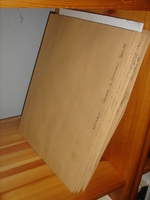Filing by Most Used
 Thursday, August 7, 2008 at 9:23
Thursday, August 7, 2008 at 9:23 This method has stood me very well over several years now. It greatly speeds up the process of both finding and putting away files. This is in line with the principle that one should avoid as much as possible having no answer to the question “What do I do with this?”
However organising files in this way does have some disadvantages. One is that I keep having to move files along the shelf. This wouldn’t matter so much if “the shelf” was just one long continuous shelf. But in fact it’s four shelves in different places across my office, and so moving files can be quite a laborious business. Another disadvantage is that retrieving files by “last used” is not as efficient as retrieving them by “most used”. Because I use quite a large number of files in any given day, my most used file may move backwards and forwards along the shelves quite a distance. It would be quicker if my most used file were always in the same place.
So how can I achieve the goal of changing to having my files in “most used” order? It occurred to me that putting a mark on a file every time I used it would quickly show which files are most used. The easiest way to count the marks would be to make the marks themselves numbers. In other words write 1 on the file the first time I put it away; then the next time cross out the 1 and put 2. That way it would be easy to put the file back in numerical order. All the most used files would end up on the right and the least used files on the left. Because a file would only move a short distance each time it was used, there would be less moving of files backwards and forwards. So the net result would be that file retrieval would be speeded up and putting files away would also be simpler.
That’s the theory anyway. I’ve armed myself with some sticky labels and am going to see whether it works in practice. The sticky labels will be going on the spines of the files so I can see the numbers clearly at all times. I’ll let you know how I get on.
You may be asking “If you’re going to put the files away in numerical order, why not file by alphabetical order like everyone else does?” The answer is partly that my most used files are still going to be put away very much in the same place each time. But more importantly one of the banes of alphabetical filing is that I have to be able to remember the name of the file. Is the file called “Bank and Credit Card statements” or “Credit Card and Bank Statements”? Did I call it “Bills, Telephone” or “Telephone, Bills”? Alphabetical filing requires more mental effort, and the more mental effort I have to put into working a system, the less likely I am to keep to it.
 Mark Forster
Mark Forster
After trying this method out for a while, I decided that it was much more cumbersome than my previous method. So with a sigh of relief I have abandoned the trial and gone back to filing by “last used”.







